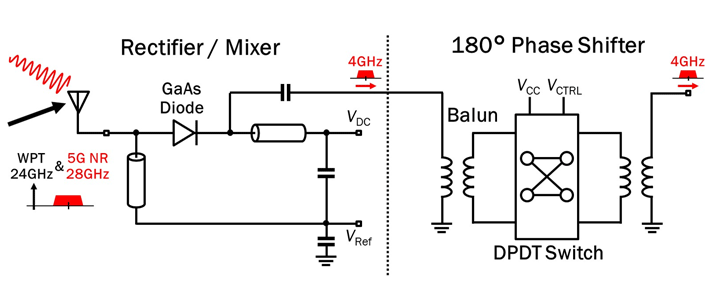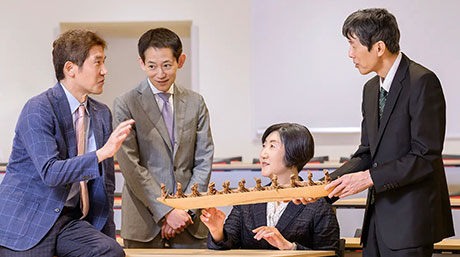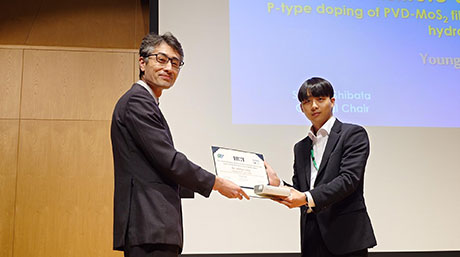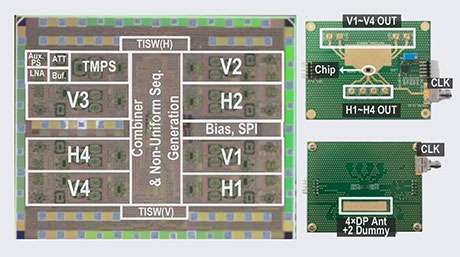Electrical and Electronic Engineering News
Towards Wider 5G Network Coverage: Novel Wirelessly Powered Relay Transceiver
Researchers have designed a novel wirelessly powered relay transceiver that improves 5G network coverage even in areas with link blockage.
A novel 256-element wirelessly powered transceiver array for non-line-of-sight 5G communication, featuring efficient wireless power transmission and high-power conversion efficiency, has been designed by scientists at Tokyo Tech. The innovative design can enhance the 5G network coverage even to places with link blockage, improving flexibility and coverage area, and potentially making high-speed, low-latency communication more accessible.
Millimeter wave 5G communication, which uses extremely high-frequency radio signals (24 to 100 GHz), is a promising technology for next-generation wireless communication, exhibiting high speed, low latency, and large network capacity. However, current 5G networks face two key challenges. The first one is the low signal-to-noise ratio (SNR). A high SNR is crucial for good communication. Another challenge is link blockage, which refers to the disruption in signal between transmitter and receiver due to obstacles such as buildings.
Beamforming is a key technique for long-distance communication using millimeter waves which improves SNR. This technique uses an array of sensors to focus radio signals into a narrow beam in a specific direction, akin to focusing a flashlight beam on a single point. However, it is limited to line-of-sight communication, where transmitters and receivers must be in a straight line, and the received signal can become degraded due to obstacles. Furthermore, concrete and modern glass materials can cause high propagation losses. Hence, there is an urgent need for a non-line-of-sight (NLoS) relay system to extend the 5G network coverage, especially indoors.
To address these issues, a team of researchers led by Associate Professor Atsushi Shirane from the Laboratory for Future Interdisciplinary Research of Science and Technology at Tokyo Institute of Technology (Tokyo Tech) designed a novel wirelessly powered relay transceiver for 28 GHz millimeter-wave 5G communication (as shown in Figure 1). Their study has been published in the Proceedings of the 2024 IEEE MTT-S International Microwave Symposium.![]()

Figure 1. Proposed transceiver array board
- The proposed transceiver design enables high power conversion efficiency and conversion gain, enhancing 5G network coverage even in areas with link blockage.
Explaining the motivation behind their study, Shirane says, "Previously, for NLoS communication, two types of 5G relays have been explored: an active type and a wireless-powered type. While the active relay can maintain a good SNR even with few rectifier arrays, it has high power consumption. The wirelessly powered type does not require a dedicated power supply but needs many rectifier arrays to maintain SNR due to low conversion gain and uses CMOS diodes with lower than ten percent power conversion efficiency. Our design addresses their issues while using commercially available semiconductor integrated circuits (ICs)."
The proposed transceiver consists of 256 rectifier arrays with 24 GHz wireless power transfer (WPT). These arrays consist of discrete ICs, including gallium arsenide diodes, and baluns, which interface between balanced and unbalanced (bal–un) signal lines, DPDT switches, and digital ICs (refer Figure 2). Notably, the transceiver is capable of simultaneous data and power transmission, converting 24 GHz WPT signal to direct current (DC) and facilitating 28 GHz bi-directional transmission and reception at the same time. The 24 GHz signal is received at each rectifier individually, while the 28 GHz signal is transmitted and received using beamforming. Both signals can be received from the same or different directions and the 28 GHz signal can be transmitted either with retro-reflecting with the 24 GHz pilot signal or in any direction.

Figure 2. Circuit structure of proposed transceiver
- The board includes gallium arsenide diodes, balun ICs, DPDT switch ICs, and digital ICs. This circuit generates DC from 24 GHz WPT signal and downconverts 28 GHz RF signal to 4 GHz IF signal simultaneously.
Testing revealed that the proposed transceiver can achieve a power conversion efficiency of 54% and a conversion gain of –19 decibels, higher than conventional transceivers while maintaining SNR over long distances. Additionally, it achieves about 56 milliwatts of power generation which can be increased even further by increasing the number of arrays. This can also improve the resolution of the transmission and reception beams. "The proposed transceiver can contribute to the deployment of the millimeter-wave 5G network even to places where the link is blocked, improving installation flexibility and coverage area," remarks Shirane about the benefits of their device.
This new transceiver will make 5G networks more common, making high-speed, low-latency communication accessible to all!
- Reference
| Conference : | 2024 IEEE MTT-S International Microwave Symposium |
| Session : | Tu1A - Advanced Systems for Wireless Power Beaming |
| Session Time : | June 18, 8:20 to 8:40 AM, Washington, D.C., USA (EDT local time) |
| Session Title : | A 256-Elements Phased-Array Relay Transceiver for 5G Network Using 24GHz Wireless Power Transfer with Discrete ICs |
| Authors : | Michihiro Ide1, Keito Yuasa1, Sena Kato1, Takashi Tomura1, Kenichi Okada1, and Atsushi Shirane1* |
| Affiliations : |
1 Department of Electrical and Electronic Engineering, Tokyo Institute of Technology, Japan |
|
* Corresponding author's email: shirane@ee.e.titech.ac.jp |
|
- Wirelessly Powered Relay Will Help Bring 5G Technology to Smart Factories | Tokyo Tech News
- A Novel 640 Gbps Chipset Paves the Way for 6G Wireless Systems | Tokyo Tech News
- Combating Fractional Spurs in Phase Locked Loops to Improve Wireless System Performance in Beyond 5G | Tokyo Tech News
- Tapping into the 300 GHz Band with an Innovative CMOS Transmitter | Tokyo Tech News
- Towards the New-Space Era with Foldable Phased-Array Transmitters for Small Satellites | Tokyo Tech News
- Preparing the Stage for 6G: A Fast and Compact Transceiver for Sub-THz Frequencies | Tokyo Tech News
- New Transmitter Design for Small Satellite Constellations Improves Signal Transmission | Tokyo Tech News
- Improving the Performance of Satellites in Low Earth Orbit | Tokyo Tech News
- Novel Architecture Can Reduce Noise-Induced Jitters in Digital Technology | Tokyo Tech News
- New and Improved Multi-Band Operational Receiver for 5G New Radio Communication | Tokyo Tech News
- Efficient Satellite Downlink with a Ka Band Dual Circular Polarization Transmitter | Tokyo Tech News
- Electricity and Data Over-the-Air: The Simultaneous Transmission of 5G and Power | Tokyo Tech News
- Introducing a Transceiver that Can Tap into the Higher Frequency Bands of 5G Networks | Tokyo Tech News
- Novel Fast-Beam-Switching Transceiver Takes 5G to the Next Level | Tokyo Tech News
- Lean and mean: Maximizing 5G communications with an energy-efficient relay network | Tokyo Tech News
- Greater Connectedness in Remote Areas: A Ka-band Transceiver for Satellite Communications | Tokyo Tech News
- Pushed to the Limit: A CMOS-based transceiver for beyond 5G applications at 300 GHz | Tokyo Tech News
- Smallest all-digital circuit opens doors to 5 nm next-gen semiconductor | Tokyo Tech News
- Three teams receive DLab Challenge Research Grant 2022 | Tokyo Tech News
- Atsushi Shirane | Researcher Finder - Tokyo Tech STAR Search
- Kenichi Okada | Researcher Finder - Tokyo Tech STAR Search
- Shirane Laboratory
- Okada Laboratory
- Laboratory for Future Interdisciplinary Research of Science and Technology (FIRST)
- Institute of Innovative Research (IIR)
- Electrical and Electronic Engineering Graduate Major|Education|Department of Electrical and Electronic Engineering, School of Engineering
- Electrical and Electronic Engineering Undergraduate Major|Education|Department of Electrical and Electronic Engineering, School of Engineering
- Latest Research News
Further Information
Associate Professor Atsushi Shirane
Laboratory for Future Interdisciplinary Research of Science and Technology,
Institute of Innovative Research,
Tokyo Institute of Technology





